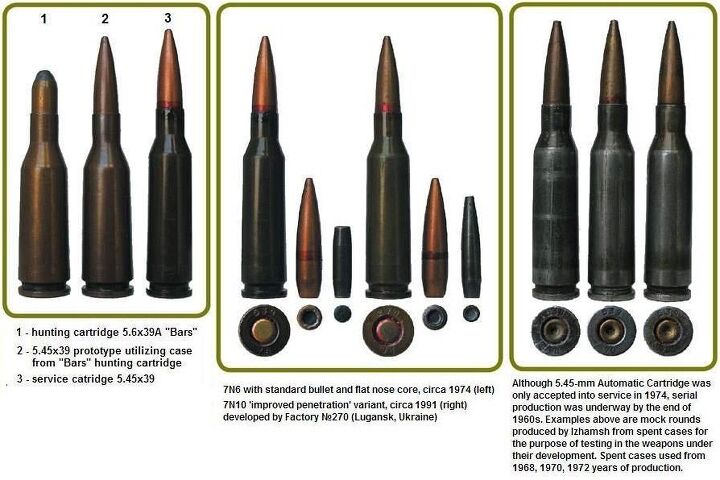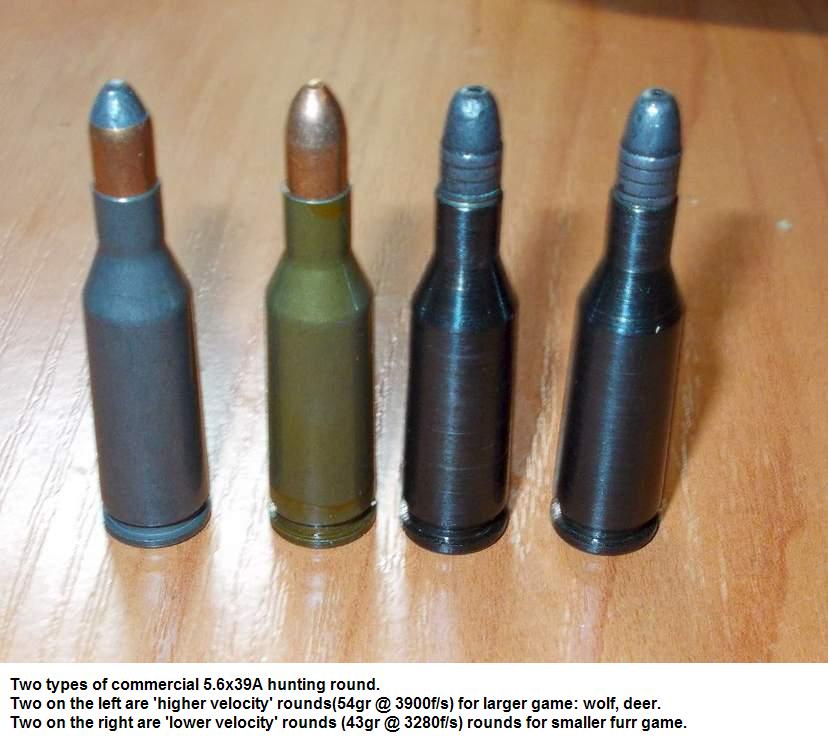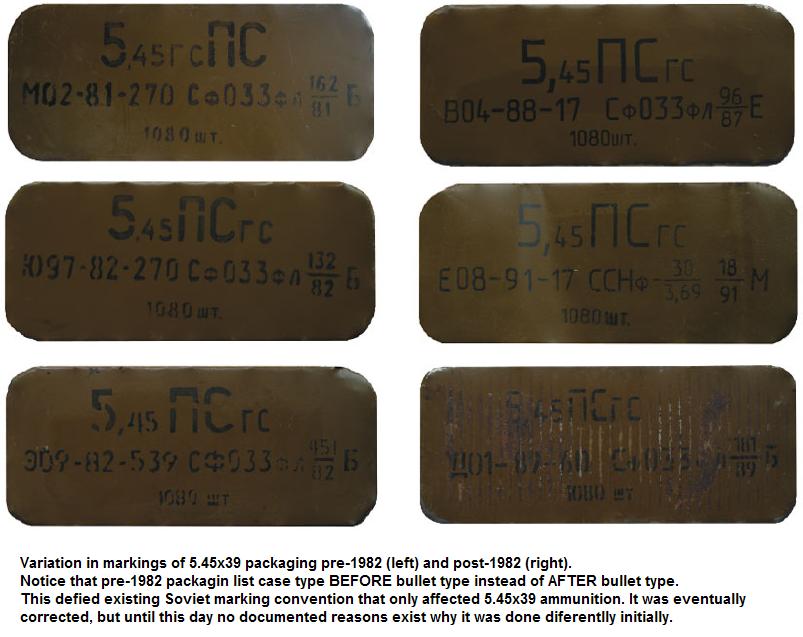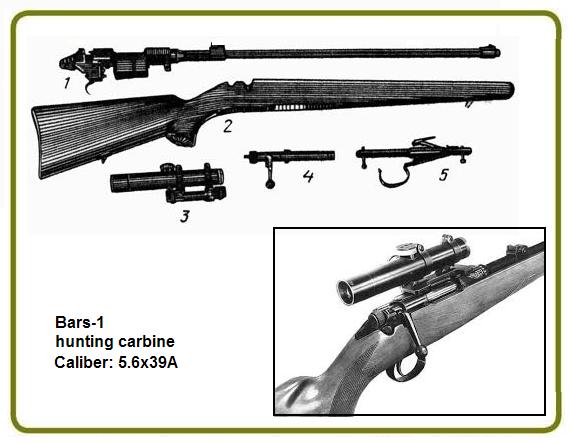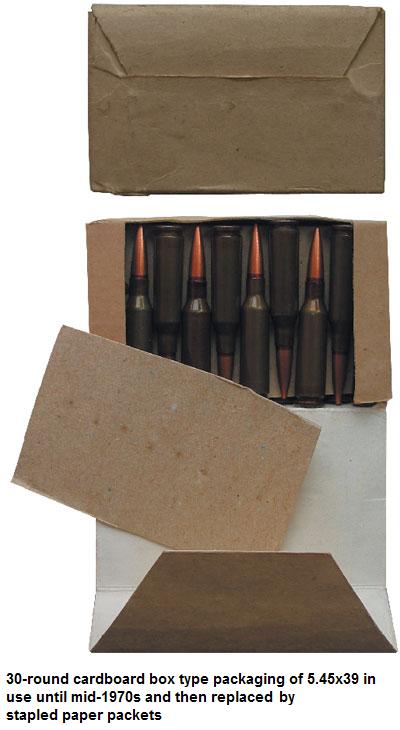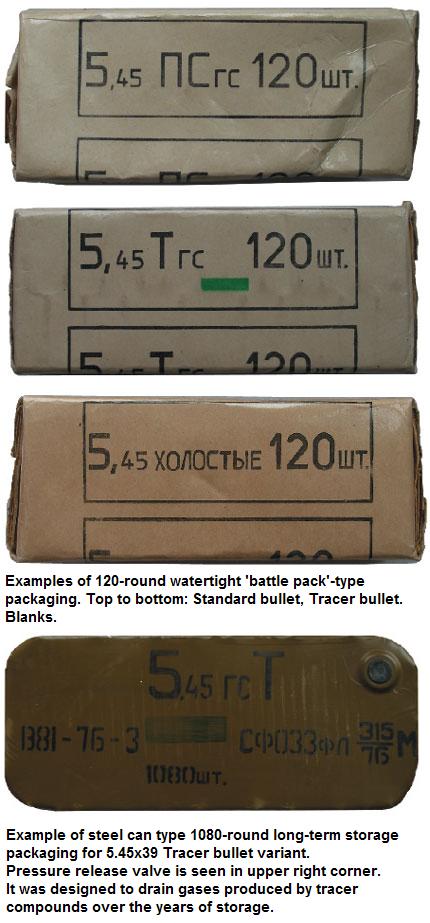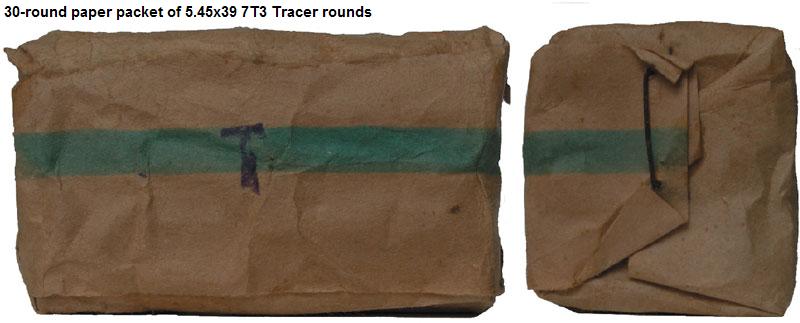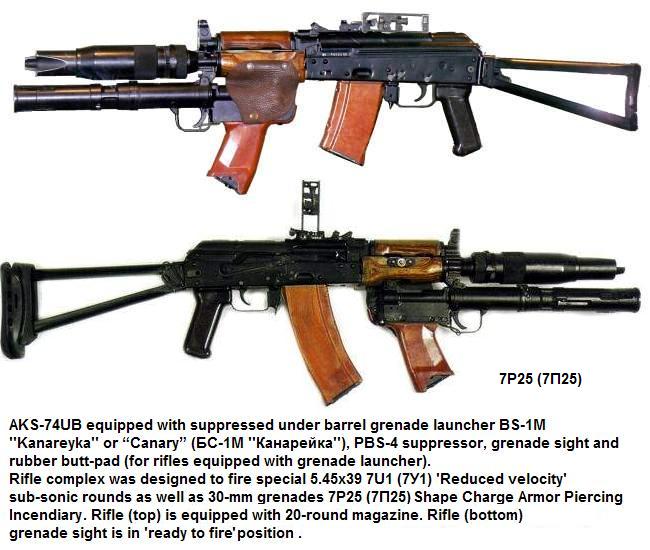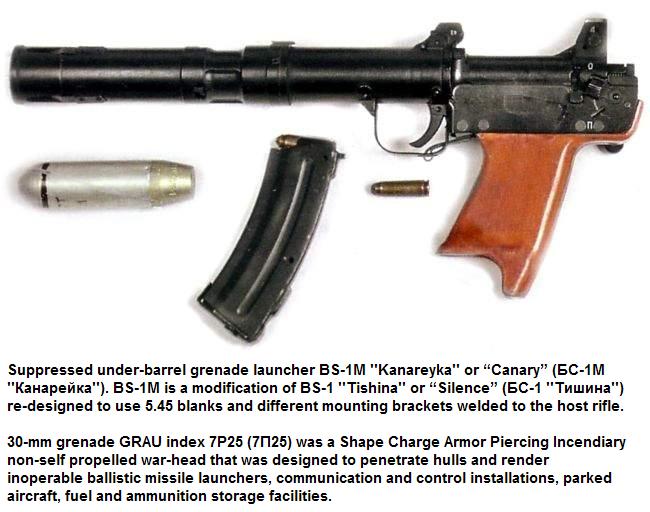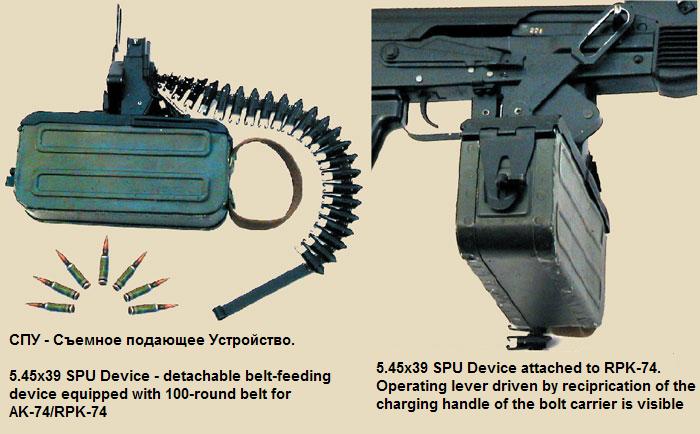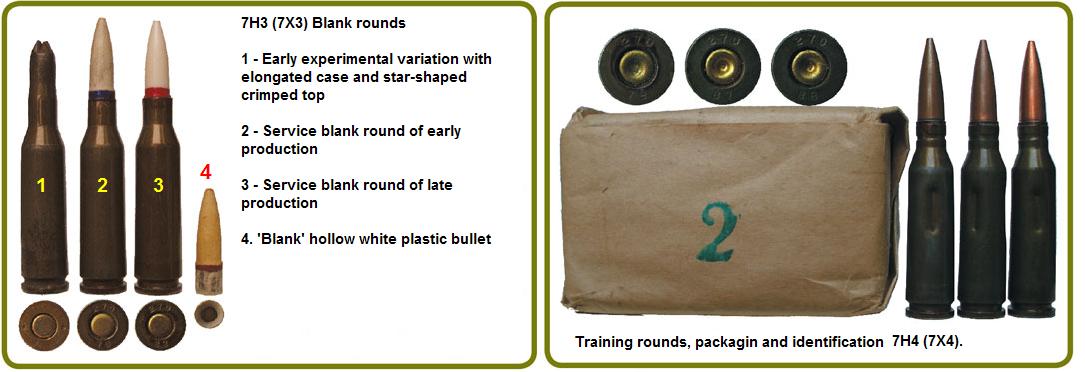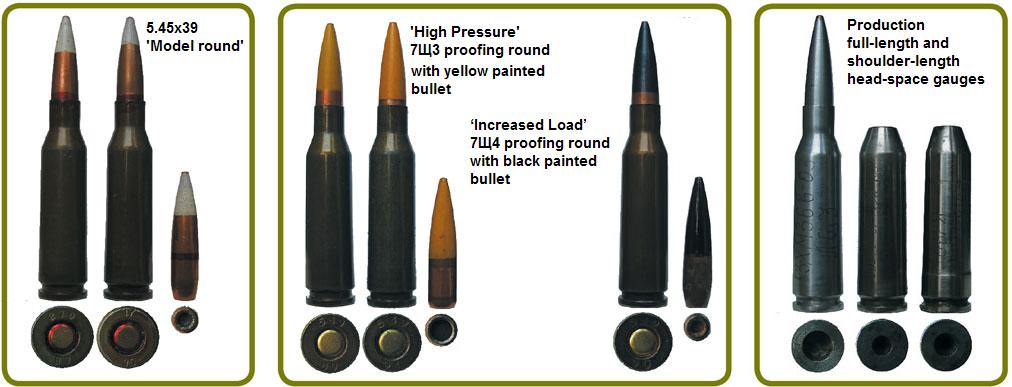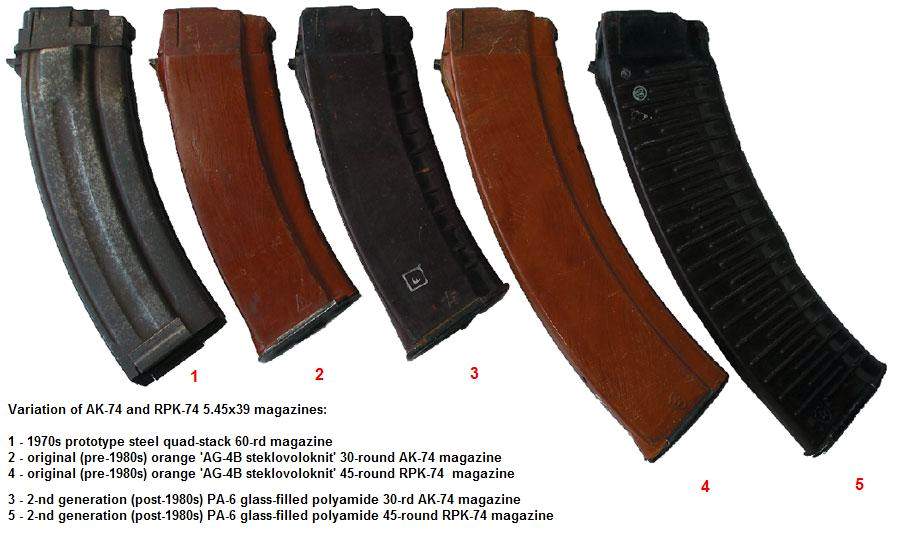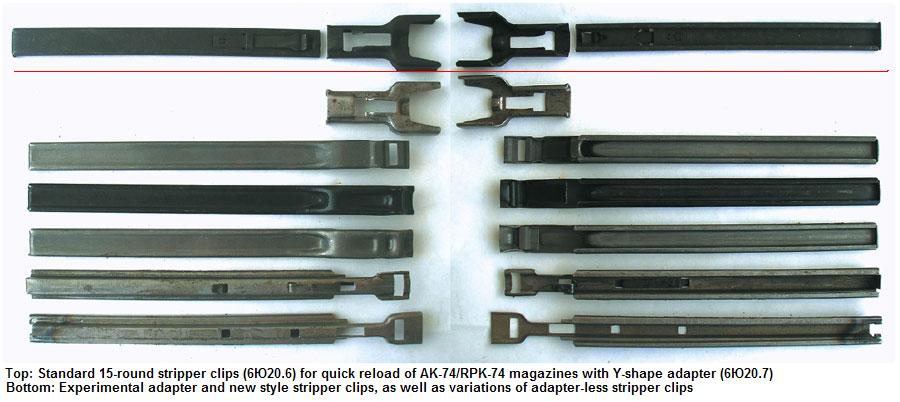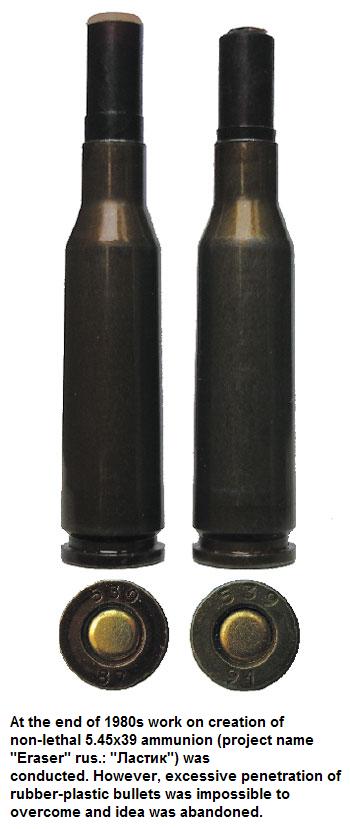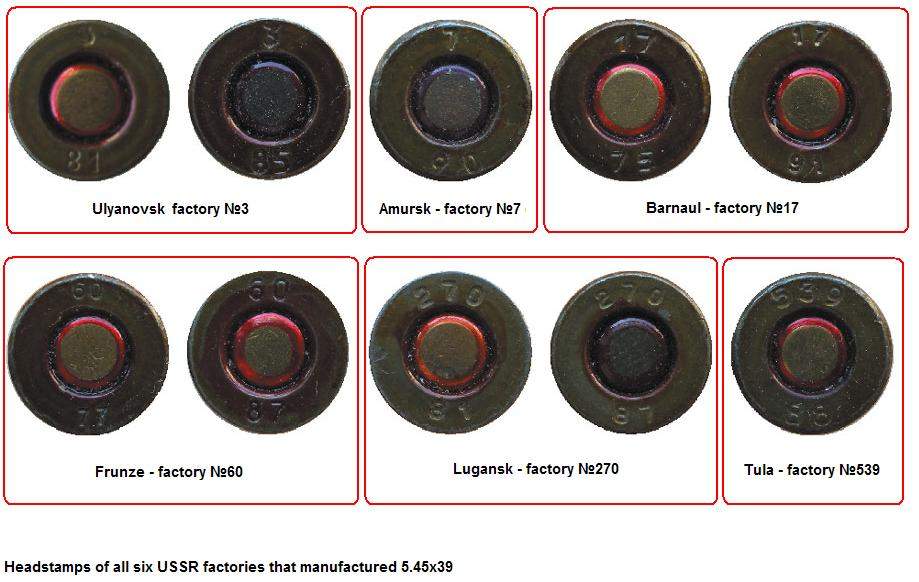This article is an English-language translation of an article written for Мир увлечений: Охота & Оружие (World of Hobbies: Hunting & Weapons) magazine, by Andrey Donets and Dmytro Adyeyev. TFB reader dnepr0mike graciously aided the blog with his translation skills to bring this to our readers. The article and its images are used with permission from Hunting & Weapons magazine.
This is Part 1 on a two-part article on the 5.45x39mm cartridge. Both articles contain information virtually unknown in the West. If there is sufficient interest in this topic, we will be able to translate Part 2 of this article as a follow up, so give us a shout in the comments if you like content like this!
PART 1
5.45×39: The little axe cuts down a big tree.
5.45×39 is a great example of how Cold War Arms Race stimulated new arms development that otherwise would have been put-off indefinitely. The idea of a small caliber general purpose round with optimized ballistics for individual automatic weapons was first proposed in the early 20th century. Unfortunately, it didn’t take on wide-spread recognition until well into the second half of the century. We speak, of course, of the works of Vladimir Grigoryevich Fedorov. He presented his own design for a reduced caliber 6.5mm automatic rifle as early as 1913. While his theories were sound and justified, backed by loads of theoretical and practical data, due to multiple reasons, including those of technological character, his works did not find wide-spread recognition for decades to come. That is until the “Arms Race” factor had entered the game.
Intelligence reports were solid…
Near the end of the 1950s Soviet intelligence reported of experimental developments conducted by Americans with the new automatic rifle AR-15 of a new 5.56 caliber by Remington. By the end of 1959 Soviet engineers had at their disposal two experimental 5.56 cartridges (that later would become known as M193). These would lay the groundwork for a future 5.45×39 – round that took almost 10 years to develop. This unusually long time can be explained by the fact that designers were forced to seek a ‘golden middle’ between seemingly conflicting requirements for a new proposed cartridge. They were asked to reduce bullet dispersion and increased hit ratio. Achieving this would normally necessitate reduction of recoil impulse and cartridge power factor. They were also asked for the new cartridge to have increased penetration and lethality. This in turn would call for increase in bullet mass and cartridge power factor. Additionally researchers had to come up with new statistical variables such as ‘effective range’ and ‘hit probability’ to be able to perform objective comparisons.
To conduct ballistics evaluations of a new American round (due to lack of any quantities of actual experimental 5.56 ammo) a ‘hybrid’ was created. It was based on 7.62×39 case necked-down to accept the American-type 5.6 caliber bullets. Bullets themselves were painstakingly re-created using American manufacturing methods. Experimental barrels were also made to replicate twist rate that of an American AR-15.
After numerous test firings conducted by НИИ-61 using ‘hybrid’ rounds, comparison charts were compiled. High instability of 5.6mm bullets (compared to native 7.62×39 round) was noted. This was the result of the length and shape of 3.56 gram M193 bullet, as well as the twist rate that was employed. Further ballistics analysis of the American bullet, it’s construction as well as penetration capability and lethality failed to render straightforward, satisfactory conclusions. As a result, all further small-caliber research studies with the American equivalent were abandoned in favor of a bullet of own design (that was yet to be developed).
First, R&D was focused on selecting the most ballistically efficient shape and construction for the future bullet. Step two of the process was optimizing bullet trajectory and recoil impulse. At that stage necessary powder charges were also worked out. This, in turn, led to the development of a new type of powder and as a result caused change in shape and dimensions of the cartridge case itself. To better the aerodynamics of the bullet it’s length was increased substantially compared to the American bullet. To maintain optimal mass-to-length ratio it was decided to manufacture the bullet core out of steel (that is also served to improve penetrative ability). For the new bullet a bi-metal (also known as CNCS) jacket was developed. It was much more resilient than tombac alloy used in the American bullet. Tombac was deemed too soft and too prone to excessive fragmentation. As the result of all experimental work, final bullet length and weight were designed to be 25.55mm and 3.4g respectively. Bullet received nomenclature index 5.45 PS that stood for caliber 5.45 mm Steel Bullet (Пуля Стальная).
New cartridge case
Through the first stages of development and testing low-impulse 5.45 cartridge utilized Pyroxylin cylindrical/tube-shaped extruded powder VUfl 545 (ВУфл 545), but was quickly replaced with lacquer-coated newly developed type Sf033fl (Сф033фл, spherical with diameter of the sphere 0.33mm with phlegmatizing agent added). New powder had higher gravimetric density and energy coefficient. New mass of the charge was determined to be 1.44g. VUfl 545 powder was not entirely forgotten. It’s still being used in 5.45 rounds equipped with ricochet reducing projectiles ПРС (Пониженной Рикошетирующей Способностью).
First two million of experimental rounds were manufactured using necked down 7.62×39 cases. This practice was already successfully employed for 5.6×39 sporting/hunting round chambered in hunting carbines “Bars-1” (Барс – Snow Leopard).
Extended trials at Odessa military district were held and revealed that round with such aggressively sloping case wall have presented a number of challenges when adopted to full-auto rifles. The use of new more energetic Сф033фл powder has allowed case volume and case-head diameter to be reduced without detrimental effects to the round’s performance. Project for reduction of the case dimensions was performed by engineering team of Lidia Ivanovna Bulavskaya. At the final stages of design finalization (performed by TsNIITochMash at city of Klimovsk) new more compact round was assigned nomenclature index – 13МЖВ. Following finalization of a bullet design (performed by manufacturing and production technology specialist – Mikhail Yegorovich Fedorov) new caliber of a bullet was designated as 5.45, measured (in accordance to USSR weapon standards) across the lands of the bore.
During earlier stages of R&D the cartridge case was produced using bi-metal, but by year 1967 more economical lacquered steel case production was fully mastered and adopted. Case length per technical documentation is actually 39.82mm. However in accordance to modern international ammunition nomenclature it became customary to round case length dimension to 39mm. Cases for 5.45 cartridge are normally loaded with brass primers KV-16 (КВ-16) diameter 5.06mm. Army designation index 7KV1 (7КВ1).
Large group of Soviet specialists in ammunition experts took part in creation of this new type of round. They all worked under director of development V.M. Sabelnikov. In parallel with the development of the standard bullet, special bullet types were developed as well. These were designed for tracer and reduced velocity rounds. New standard 5.45×39 round received GRAU index – 7N6 and was officially accepted into service in 1974.
Despite being accepted into service only in 1974 mass production of the new round, however, had been going on for years, since the end of 1960s. Along side with standard 7N6 round, specialized rounds were also accepted into service. 7T3 (7Т3) – with tracer bullets, 7U1 (7У1) – reduced velocity rounds, 7Kh3 (7Х3) – blank and 7Kh4 (7Х4) – training rounds.
Production was established at six cartridge factories across Soviet Union at:
Ulyanovsk – factory №3 (Eastern-most end of European part of Russia, about 450 miles east of Moscow)
Amursk – factory №7 (Far East part of Russia bordering North-Eastern China)
Barnaul – factory №17 (Western Siberia southern most part of Central Russia bordering Kazakhstan)
Frunze – factory №60 (Presently Bishkek, Kyrgyzstan – former USSR republic in Central Asia)
Lugansk – factory №270 (Eastern-most part of Southern Ukraine – former USSR republic)
Tula – factory №539 (Centrally located in European part of Russia, about 100 miles south of Moscow)
Standard bullet
Cartridge 7N6 was equipped with 3.4g 25.55mm long boat-tail bullet. The bullet consisted of a lead under-lined bimetal jacket with a flat-nosed steel core. The type of steel used for the core was Soviet Type 10 steel (US equivalent: 1010, 1012, 1110 – top end of low carbon/mild steel variety). The flat-nosed core did not extend all the way into the tip of the bullet thus creating a hollow cavity in the front portion of it. The bullet muzzle velocity was between 870 – 890 m/s (2850-2920 fps).
In later years as levels of individual protection improved, mild steel core was replaced with hardened core made of Type 65G, 70 or 75 steel alloy (US equivalents for Steel 65G are – 1066, 1566, G15660; for Steel 70 – 1070 and for Steel 75 – 1074). A new modification received a designation of 7N6M and was accepted into service in 1987; however 7N6M was not reclassified as an ‘improved penetration round’ and continued to be marked the same as the 7N6; the bullets have not received special color markings either.
As armor continued to improve and titanium plates came into use it necessitated the search of new methods of improving 5.45×39 penetrative ability. In 1991 specialists of factory №270 (LPZ, Lugansk factory) developed a new bullet design which had a pointed core; however it was still made of hardened 70 or 75 high-carbon steel alloy. The new bullet was heavier; in turn the powder charge was increased to maintain same muzzle velocity. The new cartridge was classified as 5.45PP (5.45ПП) where ‘ПП’ stands for Improved Penetration. It was accepted into service and received GRAU index 7N10.
USSR fell apart before new manufacturing process was adopted by any other Soviet factory. With technical knowledge now owned by Lugansk Factory in independent Ukraine, Russian manufacturers were forced to go back to the drawing board and in expedited fashion ‘develop’ manufacturing of 7N10 on their own. As the result this process would give way to a number of ‘modernized’ versions of 5.45×39 which will be covered in Part 2 of the article.
Tracer bullet
Another major variation of 5.45 bullet (that was under development for almost as long as standard bullet) was tracer variety. It was constructed of bi-metal jacket with a lead core in the nose and tracer compound in the base. Due to tiny internal diameter and capacity, tracer compound was loaded directly into the jacket thus forgoing use of special ‘tracer containment cup’. To improve ignitibility compound was made two-part: main tracing component topped with ignition initiating component. Production bullet length was 26.54mm and weight 3.36g. After 1976 new shorter (25.32mm) and lighter (3.2g) bullet was selected as a replacement for the original bullet. Shortened variant suffered practically no ballistics degradation but due to smaller bearing surface area reduced wear on the barrel bore. Round was loaded with 1.41g of Sf0033fl (Сф0033фл) powder and received additional ‘T’ marking on the metal can (i.e. 5,45 гс Т) and GRAU index 7T3. Bullet tips were also marked with green paint. Metal cans with tracer ammo received a green rectangle to denote bullet type as well as were equipped with a pressure release valve built-in into the lid. It would allow release of gases normally produced by tracer compound during prolonged storage. Tracer rounds were packed into paper-wrapped packets of 30, and each packet was marked with a green stripe and stamped letter ‘T’.
Reduced velocity
Another variation of 5.45 that was accepted into service was 5.45US (5,45УС – Уменьшеной Скорости or Reduced Velocity); GRAU index 7U1 (7У1). It was designed for use with PBS-type flash and sound suppressors. Successful use of PBS-1 and 7.62mm AKM warranted development of similar capability for the new 5.45mm round. Along with development of ‘silent bullets’ new versions of PBS were also developed. PBS-4 – evolutionary development based on PBS-2 and PBS-3 was accepted into service along with new Reduced Velocity round.
During it’s development engineers met and overcame a number of physical and technological difficulties associated with reliably suppressing new round while in fully automatic mode. Initial idea of creating universal Reduced Velocity round that would work identically across all variations AK74 as well as RPK-74 was quickly rejected. Designers concentrated their effort on perfecting new round only for use with specially modified AKS-74U equipped with improved variant of PBS-4. As the result new special modification of AKS-74U equipped with improved PBS-4 was produced. It received new designation AKS-74UB (АКС-74УБ) and received separate GRAU index 6P27 (6П27). This measure reduced use of this specialized variation only to special units of KGB, MVD and MO USSR (MO – Ministry of Defense). Optionally AKS-74UB could be equipped with suppressed under-barrel grenade launcher BS-1M ”Kanareyka” or “Canary” (БС-1М ”Канарейка”). This novel grenade launcher was a modification of BS-1 ”Tishina” (БС-1 ”Тишина” or “Silence”) re-designed to use special 5.45 PKhS blanks and different mounting brackets that needed to be welded to the host rifle. To fire grenades comfortably and accurately, new weapon complex was equipped with grenade sight (attached to the base of a standard rear AKS-74U sight) and rubber butt-pad. This modification received GRAU index 6S1 (6С1).
30-mm grenade GRAU index 7P25 (7П25) was a Shape Charge Armor Piercing Incendiary non-self propelled war-head that was designed to penetrate hulls and render inoperable ballistic missile launchers, communication and control installations, parked aircraft, fuel and ammunition storage facilities.
By the end of 1970s was developed first variant of the Reduced Velocity round. It consisted of standard 7N6 (7Н6) bullet and reduced powder charge. Bullet tips were painted black and area where bullet and case mouth met were strengthened with additional application of lacquer. Later another bullet was developed with all-lead core and reduced ogive radius. These received distinct purple-painted tips, however soon it was discovered that bullet weight was insufficient to insure 100% reliability of gas system. Bullet was further modified by addition of the core maid of tungsten-cobalt alloy (RC hardness 73+). Diameter of the bullet was also increased slightly to improve muzzle pressure from 5.65mm to 5.67mm. These bullets have a characteristic step-down in the area where bullet is seated into the case. New bullet had length of 24.3 mm and was propelled by 0.31g of P-125 (П-125) pistol powder. New weight of the bullet was 5.2g and muzzle velocity was 303m/s. Finalized version of 7U1 (7У1) as well as production techniques were developed at factory №270 (LPZ) in Lugansk, Ukraine near the end of 1980s.
Proofing rounds
For proofing of new 5.45 caliber weapons new ‘High Pressure’ (5,45ВД) and ‘Increased Load’ (5,45УЗ) rounds was developed. First was designed to test-proof barrels and second to test-proof strength of the locking mechanism.
‘High Pressure’ round received GRAU index 7Sch3 (7Щ3) and was equipped with a 3.5g steel core bullet and over-loaded with 1.52g of standard powder. Due to increased weight this bullet was lacking boat-tail. It was almost entirely painted yellow; from the tip to the mouth of the case. Distinction was made to clearly denote it’s special purpose and to prevent accidental or unintentional use.
‘Increased Load’ round received GRAU index 7Sch4 (7Щ4) and was equipped with a standard steel core bullet and over-loaded with 1.46g of SSNf 30.3/69 (ССНф 30.3/69) powder. As with 7Щ3 it was also almost fully painted black instead of just a tip.
A third type was also developed and was called ‘Model Round’ (Образцовый патрон). It was manufactured using mass-production components but selected with additional scrutiny given to nominal dimensional characteristics of the round. It was designed to test accuracy of the new weapon modifications, comparison purposes between prototypes and standard service rounds as well as ballistic calculations and other field research. Bullet tips of ‘Model Rounds’ were painted white.
Blank and training rounds
At the end of 1970s for training purposes at TsNIITochMash by Volkov and Iogansen was developed a specialized blank round. First experimental blank rounds had an elongated case with a star-shaped crimped mouth. However after trials it was redesigned to utilize standard case equipped with a hollow bullet made of white plastic. It received GRAU index 7Kh3 (7Х3). It was designed to be used with a special reduced caliber blank-firing adapter that provided sufficient pressure to operate gas system and ensured guaranteed disintegration of plastic bullet upon exit. Until 1980s blank rounds had plastic bullets sealed to the case mouth with purple lacquer-sealer and red lacquer-sealer thereafter.
Around the same time Volkov also developed a dummy round: GRAU index 7Kh4 (7Х4). It used a standard case, disabled primer and standard bullet. Four longitudinal impressions were added to the case to differentiate from other types. Bullets were seated into the cases ‘extra tight’ and lacquer-sealer was not applied.
During USSR times 5.45×39 did not have standard Incendiary or Armor Piercing Incendiary loading, unlike 7.62×39. This was simply due to the very small internal capacity of the bullet and an inability to place any reasonable effective amount of incendiary components.
5.6×45 ‘Biathlon’
Another bright albeit short-lived episode in the history of USSR’s small-caliber intermediate ammunition development was 5.6-mm ‘Biathlon’ sporting cartridge. In the middle of 1960s in parallel with 5.45 automatic rifle cartridge, work on the new sporting round began. Same as with the military variant 7.62×39 case that was selected as a parent case. In contrast to a military round, sporting case was designed to be made of brass by default. The new cartridge came out pretty powerful – 45mm long case allowed fairly stout powder charge topped with 25mm long bullet that weighed 4.93g. Additional ‘3-dimple’ crimping around the primer circumference was added. Izhevsk designers Anisimov and Susloparov developed first in the world pure biathlon rifle BI-5 (БИ-5). It was equipped with quick reload mechanism and small recoil impulse. New biathlon round was not mass produced at first. Numerous trial batches were made throughout the end of 1960s and the beginning of 1970s. Small-batch production of BI-5 was established between 1973 and 1975 in one of the custom/research workshops of Izhmash factory. First ‘open world’ trials were held during the all-Soviet biathlon competitions and in 1976 BI-5 had it’s first World debut during the Winter Olympic games in Innsbruck, Austria. Results surpassed everybody’s expectations. All gold medals in Biathlon were taken by the USSR team. The new Soviet cartridge became an overnight sensation, while the military version of 5.45×39 remained to the world Top Secret, securely hidden behind the Iron Curtain.
Sadly a year later the world of biathlon said goodbye to the high-power cartridges. In 1977 International Biathlon Union (IBU) voted in favor of new rules in accordance to which starting from 1978 standard round for International Biathlon Competition became .22LR and the maximum distance to target was reduced from 150 to 50 meters. Safety concerns were sighted as biathlon was gaining popularity as a spectator sport.
Soviet Minimi
In the second half of 20-th century an idea of dual feed-type light machine gun was circulating in designer circles. It was soon successfully implemented in Belgian-made FN Minimi/M249, Israeli-made Negev and Czech-made Vz.52/57. Izhevsk designers took on this idea in the fall of 1971. The project goal was to use RPK74 as a base to develop a new Unified Feed Machine Gun (PU – ПУ – Пулемет с Унифицированной подачей) with primary belt-feed mechanism as well as the ability to use standard AK-74 box-magazines. The new machine gun was called to increase rate of fire over RPK-74 by 50%. Many accomplished Soviet gun designers took part in this project including Kalashnikov, Dragunov, Nesterov and Aleksandrov. By the end of 1973 they had completed drawings for the proposed machine gun. In the spring of 1974 the first firing prototype underwent trials at Izhmash’s own testing range. After completion of preliminary in-house trials development received a code-name ‘Poplin’ and was handed over to TsNIITochMash for improvements and subsequent trials at the testing grounds of the Ministry of Defense. Several different prototypes were developed. Alongside several variation of belts (200 rounds each) and detachable aluminum belt-cans were designed as well. The new belt-fed machine gun was already able to accept standard AK-74 and RPK-74 box magazines but work didn’t end there. While project ‘Poplin’ was under development two more increased capacity magazines were designed and submitted for testing. A 100-round disk magazine was developed by designer Kozlov and another 100-round drum magazine was developed by designer Paranin.
The last working prototype of Unified Feed Machine Gun (PU) was assembled and tested in 1978, but soon after the project was canceled. The Defense Ministry review concluded that as the result of the higher rate of fire and unified feed, weight and dimensions of the gun increased substantially. Additionally, unified feed mechanism was more complex and couldn’t offer high-enough reliability due to its significant difference in energy required when operating belt-fed versus box-magazine.
Later-on research and experience gained from project ‘Poplin’ resulted in the development of a separate detachable belt-feeding device (СПУ – SPU). The device allowed use of 100-round belts on any standard AK-74 or RPK-74 and was driven by a bolt carrier via a lever attached to the charging handle. Ultimately this project was also abandoned because of excessive complexity of the mechanism and complicated individual tweaking of the components.
Convenience
It was believed that under modern combat conditions a soldier inevitably would be faced with the necessity to reload his empty magazines quickly. To assist in this task 15-round stripper clips were developed 6U20.6 (6Ю20.6). These would be manually pre-loaded before-hand and stored in an ammo bag along with loaded magazines. When need arose a soldier would attach said stripper clips to the top of the magazine via supplied Y-shaped adapter 6U20.7 (6Ю20.7) and perform fast reloading under battle-like conditions. Several other types of stripper clips were developed later, including ones that did not require a separate Y-shaped adapter, but neither of those were officially adopted.
Packaging and Markings
Initially 5.45×39 ammo was packed into cardboard boxes 30 rounds per box as per capacity of a standard AK-74 magazine. By the middle of 1970s it was decided to replace cardboard boxes with more economical and simplistic stapled paper packets. Thirty-six packets were packed into a hermetically sealed steel can totaling 1080 rounds per can. Two 1080 round cans were then packed into a standard wooden ammo crate for a total of 2160 rounds. The top of the crate was stenciled with the type of ammo inside. Ammo was also packaged into water-tight ‘battle packs’- four 30-round packets per pack, for a total 120 rounds. Packs were stored in a wooden crate omitting metal cans, 2160 rounds per crate total. Ammo destined to be packed into water-tight ‘battle packs’ had primers additionally protected by a black oxide coating. From 1988 this requirement was discontinued.
Crates, cans and packs loaded with special types of rounds were also color-marked by painting respective color stripes or rectangles in addition to stenciled markings. Tracer round packaging was color-marked in the form of green stripes or rectangles, while ‘reduced velocity’ rounds were marked with green and black stripes or rectangles.
Unusual and somewhat atypical for Soviet nomenclature was the fact that the initial markings on 5.45×39 packaging differed from the traditional marking scheme adopted by Soviet Army. According to convention ammo was to be identified by specifying one after another following characteristics of the cartridge: Caliber (5.45×39), Bullet type (ПС – Standard Bullet, Т – tracer, УС – Reduced Velocity) and Case type (ГЖ – bi-metal or ГС – lacquered steel). However, for reasons unknown and undocumented up until 1982 all types of 5.45×39 packaging listed case type after caliber instead of bullet type. Example: 5,45гсПС instead of 5,45ПСгс.
‘Center of gravity shifting bullet’ legend
It is worth mentioning that the unusually small new cartridge was met with skepticism in military and designer circles. “Grandfather of Soviet Avtomat” Mikhail Kalashnikov was categorically against a new small caliber all-steel bullet. He was arguing at many technical review meetings that ‘this so called punch of a bullet’, as he named it, (referring to a stamping punch) will insure that no barrel will survive for long. To his credit first test barrels made for this round had hard time maintaining zero past 2000 rounds. At the same time Ministry of Defense demanded no less than 10 000 rounds for a life span of the barrel. To solve this problem barrel experts from NII-13 as well as specialists from Kovrov and Izhevsk factories were called to assist. With their combined efforts technology was developed allowing to extend life-span of AK-74 barrels to 12 000 rounds.
Characteristic trademark of the 5.45×39 round is it’s strong tendency to loose stability and tumble when met with an obstacle. This very unusual behavior early on created a plethora of myths of a ‘magic bullet’, ‘dum-dum’, bullet that’s changing it’s center of gravity and thus inflicting devastating wounds. A ‘New Scientist’ periodical in it’s June 9 1983 Technology section review even called this round illegal (one that violates international arms agreements). Because in their understanding the small lead plug in the tip of the bullet was sufficient to shift upon impact and drastically change the bullet’s center of gravity thus causing the projectile to tumble while creating “all the unpleasant effects of a ‘dum-dum’ bullet”. Reality of course was far different from the imagined horrors of the ‘new Soviet illegal evil bullet’. Center of gravity was always near the longitudinal axis of the projectile, albeit closer towards the rear and in actuality never shifts or changes. Because of the length to width ratio, weigh distribution and rate of twist selected, bullet in flight is balancing on the verge of gyroscopic stability. Upon meeting it’s target the co-action of two forces – mass and resistance of the media – cause the tumbling behavior that was responsible for bullet’s devastating wounding potential and it’s fearsome reputation.
Magazines
AK-74 was originally intended to be fed only from 30-round box magazines (GRAU index 6L23). Newly designed light magazines were molded from orange colored fiberglass AG-4B (стекловолокнит АГ-4Б). Increased capacity 45-round magazines (GRAU index 6L26) were designed for use with RPK-74 light machine guns and were made in an identical fashion as standard AK-74 magazines.
From the beginning of the1980s 30 and 45-round magazines were slightly redesigned and improved. A new glass-filled polyamide PA-6 (ПА-6) dark-plum material replaced the older orange one.
Around the beginning of the 1970s work on magazines with even higher capacity was conducted. Steel 60-round quad-stack with realignment to double-stack were in the testing stages when work was canceled due to budgetary constrains. Practical realization of the quad-stack development didn’t take place until early 2000s when Russian Federation accepted into service a new increased capacity black polymer quad-stack 60-round magazine. (RF Patent № 2158890).
 Your Privacy Choices
Your Privacy Choices

